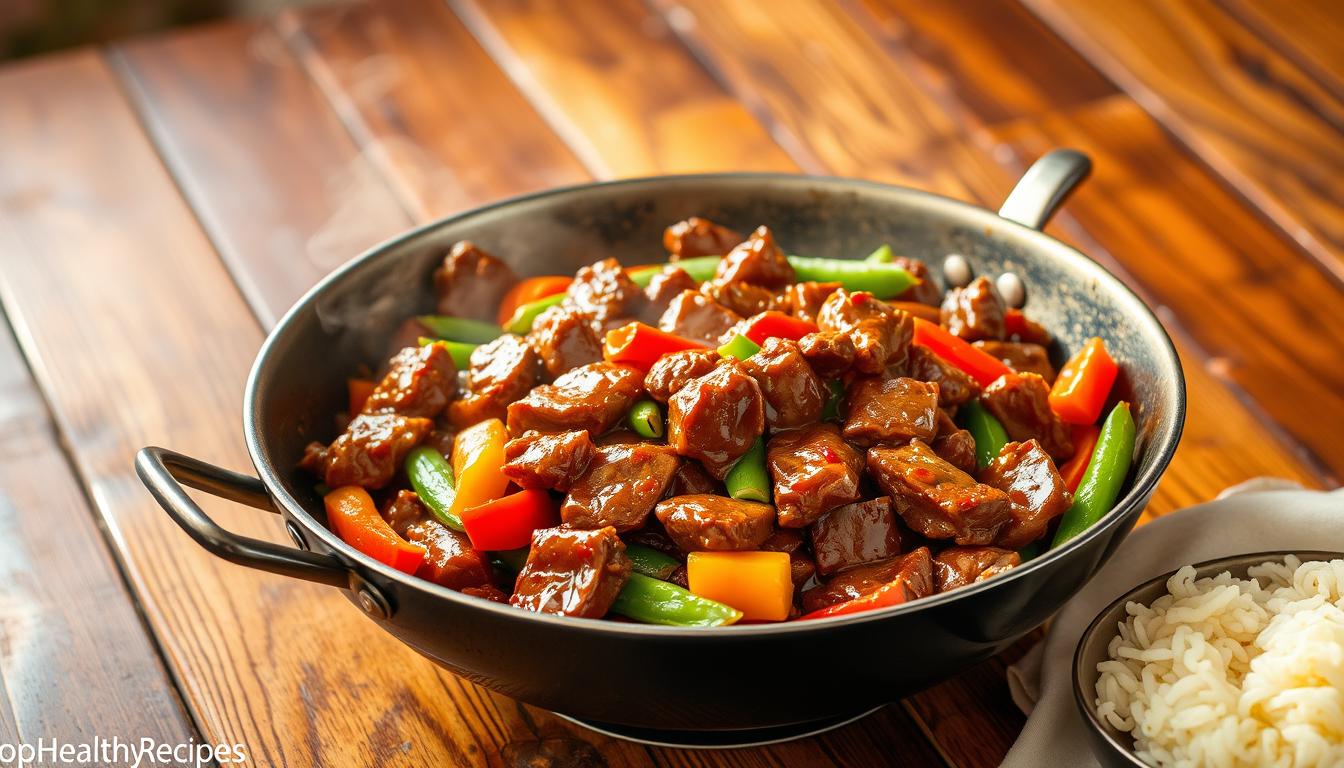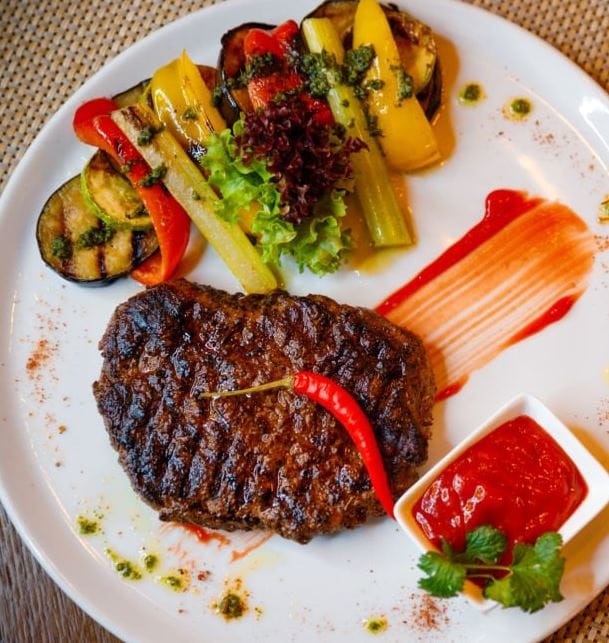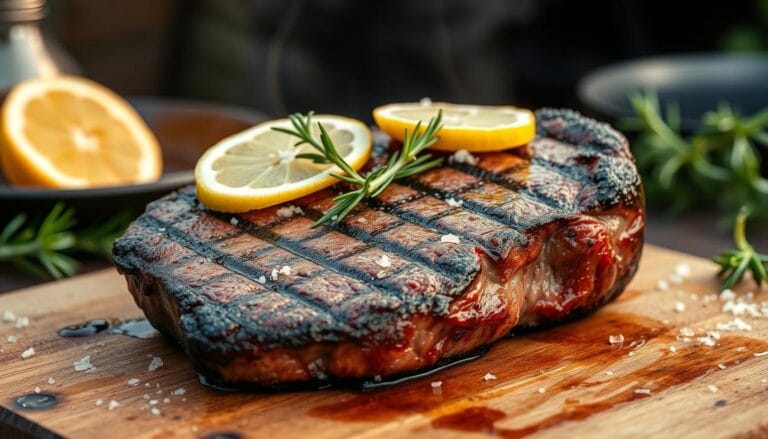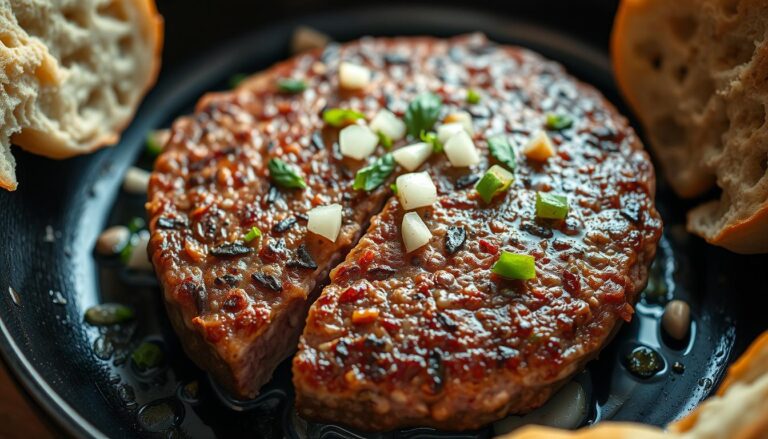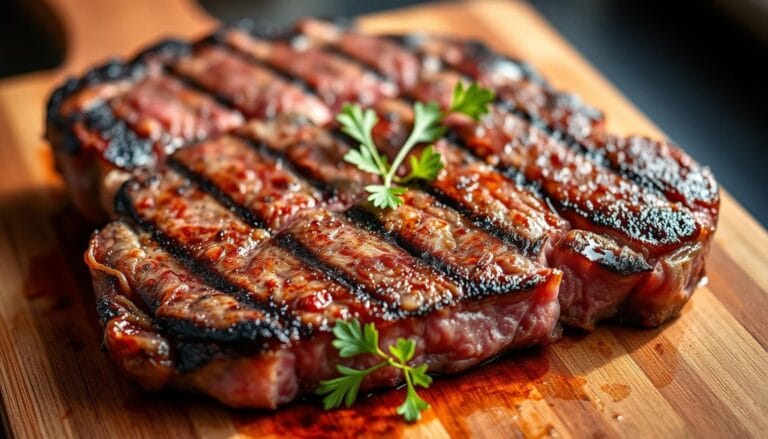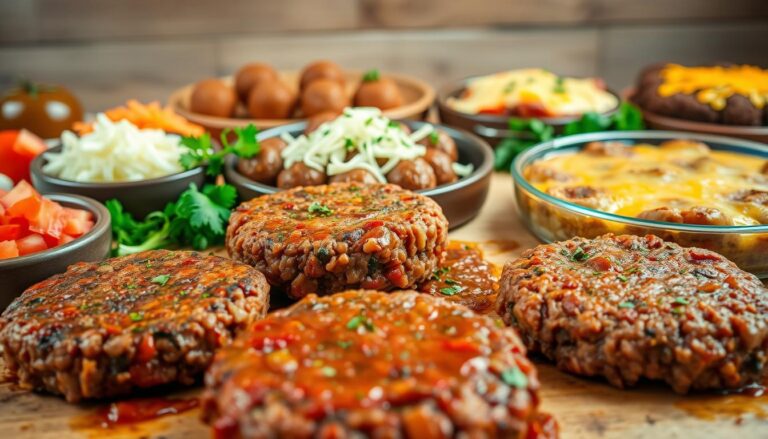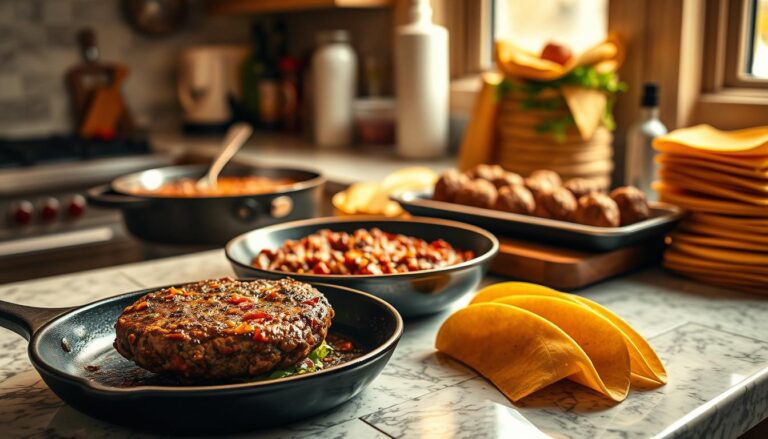Explore Tasty Hot and Spicy Beef Meal Ideas
Table of Contents
Explore Tasty Hot and Spicy Beef Meal Ideas
Are you ready to ignite your taste buds with the bold flavors of spicy beef dishes? Whether you’re a seasoned spice enthusiast or just looking to add a little excitement to your meal routine, the world of hot and spicy beef recipes is vast and tantalizing.
From the sizzling stir-fries of Asian cuisine to the hearty, slow-cooked stews of Latin America, spicy beef is a culinary delight that transcends cultures. You can explore various cooking techniques, essential ingredients, and regional variations that make these dishes a staple across the globe.
Key Takeaways
- Discover diverse cooking techniques for hot and spicy beef dishes.
- Learn about essential ingredients that make spicy beef recipes flavorful.
- Explore regional variations of spicy beef stir-fries and stews.
- Get inspired to create delicious, fiery beef dishes at home.
- Find quick and easy meal ideas for weeknights or dinner parties.
What is Hot and Spicy Beef?
Hot and spicy beef is a wide range of dishes that mix heat and flavor perfectly. These dishes use spices and peppers to add depth and heat to the beef. This makes the beef taste richer and more complex.
Definition and Characteristics
Hot and spicy beef dishes are known for their bold flavors. They use chili peppers, spicy sauces, or seasonings to add heat. This heat balances the richness of the beef, creating a unique taste experience.
Spices and chili peppers in these recipes add both heat and flavor. Different cuisines use unique spice blends and chili varieties. For example, Sichuan beef uses Sichuan peppercorns for a numbing heat. Beef Schezwan combines chili peppers with garlic and spices for a fiery taste.
Popular Types of Hot and Spicy Beef
There are many popular hot and spicy beef dishes around the world. Each has its own unique taste and characteristics. Some favorites include:
- Sichuan Beef: Known for its numbing and spicy flavor, thanks to the use of Sichuan peppercorns and chili peppers.
- Beef Schezwan: A spicy and savory dish that combines beef with Schezwan sauce, known for its fiery and slightly sweet flavor.
- Korean Spicy Beef Bulgogi: A marinated beef dish that is grilled or stir-fried, known for its sweet and spicy flavor profile.
| Type | Key Ingredients | Flavor Profile |
|---|---|---|
| Sichuan Beef | Sichuan peppercorns, chili peppers, beef | Numbing, spicy |
| Beef Schezwan | Schezwan sauce, chili peppers, garlic | Fiery, savory |
| Korean Spicy Beef Bulgogi | Gochujang, soy sauce, sugar, beef | Sweet, spicy |
Nutritional Benefits
Hot and spicy beef dishes are not just tasty but also good for you. Beef is full of protein, vitamins, and minerals like iron and zinc. The spicy parts, like chili peppers, have capsaicin. This has health benefits like boosting metabolism and acting as an antioxidant.
Eating hot and spicy beef can be a tasty way to get more nutrients. Just make sure to balance the heat with other healthy ingredients. Choose cooking methods that keep the beef’s nutrients intact.
Essential Ingredients for Hot and Spicy Beef
Making the perfect hot and spicy beef dish needs careful picking of ingredients. You want to mix spices, seasonings, marinades, and veggies just right. This mix can make your hot and spicy beef recipes even better.
Spices and Seasonings
The heart of a great hot and spicy beef dish is its spices and seasonings. Chili peppers are key, bringing the heat that makes these dishes special. You can use jalapeños or habaneros to adjust the heat level.
Spices like Sichuan peppercorns add unique tastes and feelings. They give a numbing “ma la” effect, which is a big part of Sichuan cooking.
- Sichuan Peppercorns: Known for their numbing effect, these peppercorns are a staple in Sichuan cuisine.
- Cayenne Pepper: Adds a sharp, fiery heat to dishes.
- Paprika: Provides a smoky depth and a vibrant color.
- Garlic Powder and Onion Powder: Enhance the savory flavor of beef.
Marinades That Pack a Punch
Good marinades are key to adding deep, spicy flavors to beef. A great marinade mixes acidic stuff like soy sauce or vinegar with spices and herbs. This tenderizes the meat and brings out more flavor.
For a spicy beef stir-fry, try a marinade with soy sauce, ginger, and chili flakes. It’s a winning combo.
- Combine soy sauce, olive oil, garlic, and ginger for a classic marinade.
- Add chili flakes or sliced jalapeños for an extra kick.
- Use citrus juice like lime or lemon to add brightness and acidity.
Vegetables That Complement
The right veggies can balance and enhance hot and spicy beef dishes. Bell peppers, onions, and broccoli are great choices. They add nutrition and texture.
For a spicy beef stir-fry, quickly sauté these veggies. It helps balance the spice and keeps them crunchy.
- Bell Peppers: Sweet and crunchy, they provide a nice contrast to spicy beef.
- Onions: Whether raw or caramelized, onions add a depth of flavor.
- Broccoli: Its slightly bitter taste can balance the richness of beef.
Cooking Methods for Hot and Spicy Beef
To make your hot and spicy beef dishes better, learn different cooking methods. The right way to cook can turn a simple dish into a masterpiece.
Mastering various cooking methods is key for hot and spicy beef. Whether you’re stir-frying, grilling, or slow cooking, each method needs attention. This ensures the perfect mix of heat and flavor.
Stir-Frying
Stir-frying is a top choice for hot and spicy beef dishes. It cooks ingredients quickly over high heat, keeping them crunchy and flavorful. To get the “wok hei” or breath of the wok, prepare all ingredients before cooking.
Key steps in stir-frying:
- Preheat your wok or large skillet to high heat.
- Add a small amount of oil and swirl it around.
- Cook the beef quickly, then set it aside.
- Add aromatics like garlic and ginger, followed by your choice of vegetables.
- Return the beef to the wok, add your sauce, and stir-fry everything together.
Stir-frying lets you be creative. Try different vegetables and spices to make your own hot and spicy beef stir-fry.
Grilling
Grilling gives hot and spicy beef a smoky flavor. This method cooks the beef over direct or indirect heat. It depends on how much char and doneness you want.
Tips for grilling hot and spicy beef:
- Preheat your grill to the right temperature.
- Season the beef with a spice rub or marinade before grilling.
- Use a thermometer to ensure the beef reaches your desired level of doneness.
- Let the beef rest for a few minutes before slicing it thinly against the grain.
Grilling works with many beef cuts, from steaks to brisket. Try different spice blends and glazes to find your favorite.
“The key to a great grilled hot and spicy beef is achieving a nice char on the outside while keeping the inside juicy and tender.”
Slow Cooking
Slow cooking makes tough beef tender and flavorful. It’s great for busy days when you want a ready-to-eat meal.
| Cooking Method | Best for | Tips |
|---|---|---|
| Slow Cooker | Tougher cuts like brisket or chuck | Brown the beef before slow cooking for added flavor. |
| Dutch Oven | Recipes that benefit from browning | Use a heavy lid to trap moisture and heat. |
| Pressure Cooker | Quickly tenderizing tougher cuts | Adjust cooking times based on the specific cut of beef. |
Slow cooking is perfect for hot and spicy beef. It lets flavors blend and the beef become tender and fall-apart.
Popular Hot and Spicy Beef Recipes
Try these hot and spicy beef recipes from around the world. They’re perfect for a quick stir-fry, flavorful tacos, or a traditional Korean dish. These recipes will satisfy your craving for bold flavors.
Sizzling Spicy Beef Stir-Fry
Spicy beef stir-fry is a classic Chinese dish. It’s great for those who love a mix of heat and flavor. Choose flank or sirloin beef and slice it thinly against the grain for tenderness.
The key is velveting the beef. This means marinating it in a mix of cornstarch, egg whites, and seasonings. A hot and spicy marinade, along with stir-fry sauce, brings bold flavors without too much heat.
Fiery Beef Tacos
Fiery beef tacos offer a Mexican twist. They balance heat and flavor with traditional spices. You can cook the beef quickly for a weeknight meal or slow-cook it for deeper flavors.
Pair the spicy beef with cool cremas, slaws, and pickled veggies. The right tortilla and assembly make your taco night special.
Korean Spicy Beef Bulgogi
Korean bulgogi gets spicy with gochujang and gochugaru. It balances heat with sweet and savory. Asian pear tenderizes the beef, adding a unique flavor.
Follow detailed marination and cooking steps for perfect caramelization. Serve with authentic banchan (side dishes) for a complete meal.
Hot and Spicy Beef Pairings
Pairing hot and spicy beef with the right sides, drinks, and sauces can make your meal better. It’s all about balancing the bold flavors of the beef with other tastes. This way, you get a complete and enjoyable dining experience.
Best Side Dishes
Choosing the right side dishes can cool down your taste buds. Try cucumber salads or yogurt-based dishes to balance the heat. Starchy sides like steamed rice or roasted potatoes soak up sauces, making each bite tastier.
For a real taste, pair your spicy beef with traditional sides. For example, Sichuan beef goes great with steamed bok choy or stir-fried broccoli. The mix of textures and temperatures adds to your meal’s depth.
Ideal Beverages
The perfect drink can make your spicy beef meal even better. Beer with a crisp finish, like pilsner or pale ale, can cool down the heat. Wine like Riesling or Gewürztraminer can also handle strong flavors.
For those who don’t drink, try ginger ale or cucumber water. These drinks refresh your palate. They work well with spicy foods because of their sweetness and carbonation.
Recommended Sauces and Dips
Condiments can elevate your spicy beef dishes. You can use simple dips like soy sauce or chili oil, or more complex ones like peanut sauce. There’s a wide range to choose from, whether for a stir fry or Schezwan beef.
For a cool contrast, try yogurt-based dips or cucumber raita. If you like more heat, sriracha or hot sauce are great. Umami-rich sauces like soy sauce or fish sauce add depth to the beef’s flavor.
Regional Hot and Spicy Beef Dishes
Hot and spicy beef dishes vary greatly around the world. From Tex-Mex to Asian flavors, each region has its own twist. You’ll find unique flavors and cooking methods in every dish.
Tex-Mex Variations
Tex-Mex is famous for its bold and spicy flavors. It combines Mexican and American cooking styles. Try beef chili con carne, spicy beef fajitas, and hot & spicy beef enchiladas for a taste.
Tex-Mex uses chili peppers, cumin, and oregano. These spices give its dishes a distinct flavor.
| Dish | Key Ingredients | Flavor Profile |
|---|---|---|
| Beef Chili con Carne | Ground beef, chili peppers, cumin | Hearty, spicy, savory |
| Spicy Beef Fajitas | Sliced beef, bell peppers, onions, fajita seasoning | Spicy, smoky, slightly sweet |
| Hot & Spicy Beef Enchiladas | Beef, tortillas, enchilada sauce, cheese | Rich, spicy, comforting |
Asian Inspirations
Asian cuisine offers many spicy beef dishes. From Sichuan’s numbing heat to Thailand’s curry pastes, there’s a lot to try. Discover the “ma la” sensation of beef Schezwan and Sichuan recipes.
Beef rendang from Indonesia and beef vindaloo from India are just a few examples. Spicy beef noodle soups from Asia also showcase the region’s diversity.
Caribbean Flavors
Caribbean cuisine mixes African, European, and indigenous flavors. It’s known for jerk-spiced and curry beef dishes. Learn about Caribbean spice blends like allspice berries and scotch bonnet peppers.
Traditional cooking methods like pit smoking add depth to these dishes. Modern recipes make them easy to cook at home.
Tips for Perfecting Hot and Spicy Beef
The secret to great hot and spicy beef is finding the right mix of spice and flavor. It’s all about balancing heat and taste. This balance makes sure your dishes are spicy but not too much.
Balancing Heat and Flavor
To get this balance right, you need to know how to mix different kinds of heat. Add aromatic spices, herbs, and other flavor boosters to enhance it. For example, in a Sichuan beef recipe, it’s not just about the heat. Sugar, acid, and fat help balance it out.
- Use fresh chilies for an immediate punch of heat.
- Incorporate dried peppers for a slow burn.
- Balance heat with aromatic spices and herbs.
- Adjust recipes to achieve your ideal heat-to-flavor ratio.
Marination Tips
Marinating is key for deep flavor and tender meat in spicy beef dishes. It’s about how ingredients affect the meat’s texture and flavor. Acidic ingredients like vinegar or citrus tenderize the meat.
“Marination is not just about adding flavor; it’s also about tenderizing the meat to achieve the perfect texture.”
Marinating times vary by beef cut. Always keep the meat refrigerated at 40°F (4°C) or below to stay safe.
Cooking Temperatures
Controlling cooking temperatures is vital for perfect spicy beef. Different methods and cuts need specific temperatures. For quick dishes like stir-fries, high heat is best to keep the meat tender.
For tougher cuts, use lower temperatures for braising. It’s important to know when your cooking surface or oil is ready. Keeping the heat steady is also key.
Key Cooking Temperature Tips:
- Use a thermometer to ensure accurate temperatures.
- Preheat your cooking surface or oil before adding the beef.
- Adjust cooking temperatures based on the doneness level you prefer.
Adjusting Spice Levels in Hot and Spicy Beef
Learning to make hot and spicy beef is more than just adding chili peppers. It’s about knowing how to adjust the spice to please everyone. Whether you’re cooking for a group with different spice likes or just want to improve your recipe, it’s important to know how to change the heat.
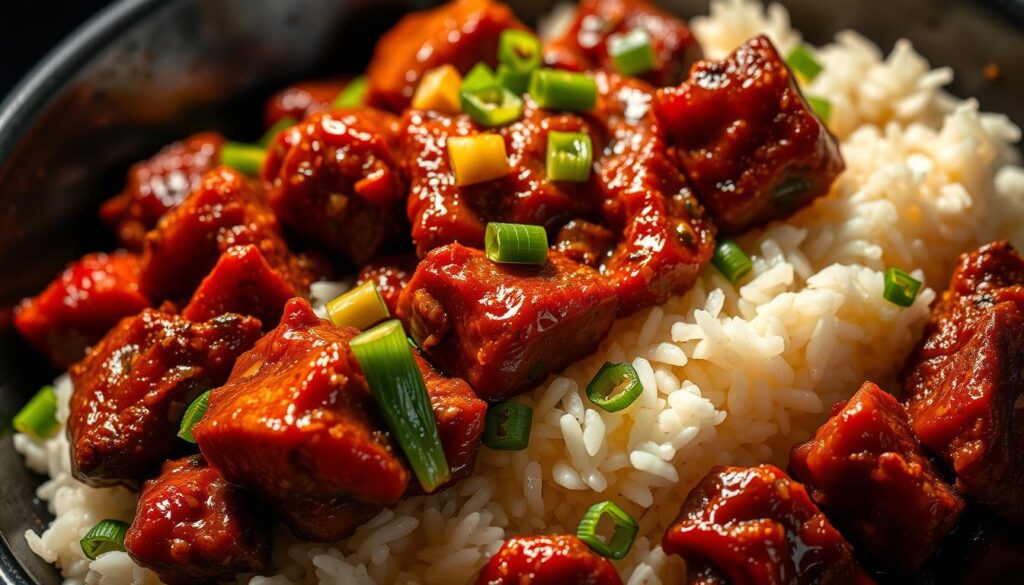
Ways to Reduce Heat
If your hot and spicy beef is too hot, there are ways to make it less spicy without losing flavor. Using dairy like yogurt or milk is a good trick. These products have casein, which binds to capsaicin and reduces the heat. You can add dairy at the end of cooking or serve it on the side.
To balance the heat, try adding a bit of sugar or honey. This can help counteract the burning feeling. Acidic ingredients like vinegar or citrus juice can also cut through the richness and heat. For Sichuan beef, a splash of rice vinegar can bring balance.
Key ingredients to reduce heat:
- Dairy products (yogurt, milk)
- Sweeteners (sugar, honey)
- Acidic components (vinegar, citrus juice)
Tricks to Enhance Heat
If you want more heat in your hot and spicy beef, there are ways to do it. Using different chili peppers and spices, like habaneros or ghost peppers, can make it hotter. Adding chili flakes or hot sauce while cooking can also increase the heat.
Chili oil or chili-infused oil is another trick. It spreads the capsaicin evenly, making the heat consistent. For real Sichuan beef, mix Sichuan peppercorns with chili peppers for a unique taste.
Methods to enhance heat:
- Using hotter chili peppers
- Incorporating chili flakes or hot sauce
- Utilizing chili oil or chili-infused oil
Customizing for Your Taste
Adjusting the spice in your hot and spicy beef lets you please everyone. Start with a recipe that’s not too spicy and add more heat at the table. This is great for dishes like spicy beef stir-fry, where you can adjust the heat to your liking.
Getting to know different types of heat and how they mix with flavors is key. Keep notes and taste as you go to improve your recipes. This way, you can make dishes that are just right for you.
“The art of cooking is not just about following a recipe; it’s about understanding the nuances of flavor and heat, and adjusting them to create a dish that’s truly your own.”
Serving Suggestions for Hot and Spicy Beef
Serving hot and spicy beef can make a meal unforgettable. Whether it’s for yourself, family, or friends, how you present it matters. It can make the meal more enjoyable.
Plating Ideas
Visual appeal is key when plating hot and spicy beef. Use colors to make your dish pop. For example, reds and oranges from the beef can look great with green veggies.
Adding different textures and heights can also make your dish more interesting. Try adding toasted sesame seeds or chopped scallions for flavor and looks.
| Plating Element | Purpose | Example |
|---|---|---|
| Color Contrast | Adds visual appeal | Red chili peppers with green vegetables |
| Texture Variety | Enhances dining experience | Crispy beef with soft noodles |
| Garnishes | Adds flavor and visual appeal | Sprinkle of sesame seeds or chopped scallions |
Meal Prep for Busy Days
Hot and spicy beef is perfect for meal prep. You can cook the beef and veggies ahead of time. Store them in airtight containers to keep them fresh.
Reheating is quick. Just mix the cooked beef with veggies and sauces. This saves time and lets you enjoy different meals all week.
- Cook beef and vegetables in advance
- Store components in separate containers
- Reheat and assemble as needed
Making It a Family Feast
Hot and spicy beef is great for family meals. It can be made to suit everyone’s taste. Set up a topping station so everyone can make their own.
Make different versions of the dish for varying spice levels. This way, everyone can enjoy it how they like.
Tips for a Family Feast:
- Offer a variety of toppings and sauces
- Prepare multiple versions with different heat levels
- Encourage everyone to participate in cooking and serving
Hot and Spicy Beef for Special Occasions
Hosting special occasions? Hot and spicy beef dishes can impress your guests. These bold flavors are perfect for any event, like birthdays, anniversaries, or holidays.
For your hot and spicy beef, think about these recipe ideas for parties. You could have an interactive hot pot experience or an elegant beef Schezwan dish that will amaze everyone.
Recipe Ideas for Parties
Impress your guests with spicy beef stir-fry or Sichuan beef recipe. These dishes can be made in any quantity. You can also add sides and accompaniments to please everyone.
- Spicy beef tacos with all the fixings
- Korean-style BBQ beef with spicy marinades
- Sizzling beef and vegetable skewers with spicy dipping sauces
Combining Flavors for Buffets
For a hot and spicy beef buffet, balance flavors with different dishes. Pair spicy beef stir-fry with cool elements like yogurt or cucumber raita. Add starchy sides like rice or naan bread to balance the heat.
Also, offer other protein options like grilled chicken or vegetables. This way, everyone can find something they like.
Impressing Your Guests
To impress with your hot and spicy beef, focus on developing complex flavors and perfect textures. Use specialized techniques and ingredients for authentic and memorable meals.
For example, add Sichuan peppercorns for depth and numbing heat. Or use fermented bean paste for umami flavor. These details will make your dishes unforgettable.
Popular Hot and Spicy Beef Brands
Many brands are known for their hot and spicy beef. They offer quality and flavor. Whether you want convenience, authenticity, or gourmet taste, there’s something for everyone.
Notable Packaged Products
Several brands have pre-packaged hot and spicy beef. Lee Kum Kee and Sriracha are famous for their products. You can find frozen entrees and refrigerated cuts for quick cooking.
When picking packaged products, check the flavor, ingredients, and value. Some may have artificial ingredients or too much sodium. Others balance convenience with great taste.
Specialty Sausages and Jerky
Artisanal producers make unique spicy beef sausages and jerky. Brands like Chorizo and ‘Nduja add special flavors. Use them in stir-fries, pasta, and rice dishes.
Choose sausages and jerky with quality ingredients and traditional methods. Some brands offer mail-order for hard-to-find items.
Gourmet Options
Food lovers can find premium hot and spicy beef products. Specialty stores and online sites have restaurant-grade ingredients. Use them for Beef Schezwan and Sichuan beef recipes at home.
Look for imported spice blends, high-end sauces, and premium beef. Some are made by famous chefs, others by small-batch producers.
Hot and Spicy Beef for Health-Conscious Eaters
Enjoying hot and spicy beef can be healthy with leaner cuts and organic choices. You can love the bold flavors without hurting your health goals. Just tweak your cooking and pick better ingredients.
Lean Cuts and Organic Options
Choosing the right beef is key for a healthy dish. Go for lean cuts like sirloin, tenderloin, or round. They have less fat and stay tender when cooked right. For example, a sirloin steak marinated in soy sauce, garlic, and ginger, then grilled, is a lean and tasty hot and spicy beef meal.
Organic and grass-fed beef is also good for you. It has more omega-3s and CLA, a fatty acid that might be good for you. These choices might cost more, but they’re better for the planet. Look for labels that say the beef is organic and grass-fed for the best nutrition.
| Lean Cut | Fat Content | Suitability for Hot and Spicy Beef |
|---|---|---|
| Sirloin | Low | High |
| Tenderloin | Very Low | High |
| Round | Low | High |
Substitutions for Traditional Ingredients
Make healthier hot and spicy beef recipes by swapping ingredients. Use low-sodium soy sauce or tamari to cut down on salt. Replace refined sugars with honey or maple syrup. In a Sichuan beef recipe, try coconut aminos instead of soy sauce for less sodium.
Swap high-calorie ingredients for lower-calorie ones. Use less oil by steaming or cooking in a non-stick pan with avocado oil. Also, use arrowroot powder or tapioca flour instead of cornstarch to cut down on carbs.
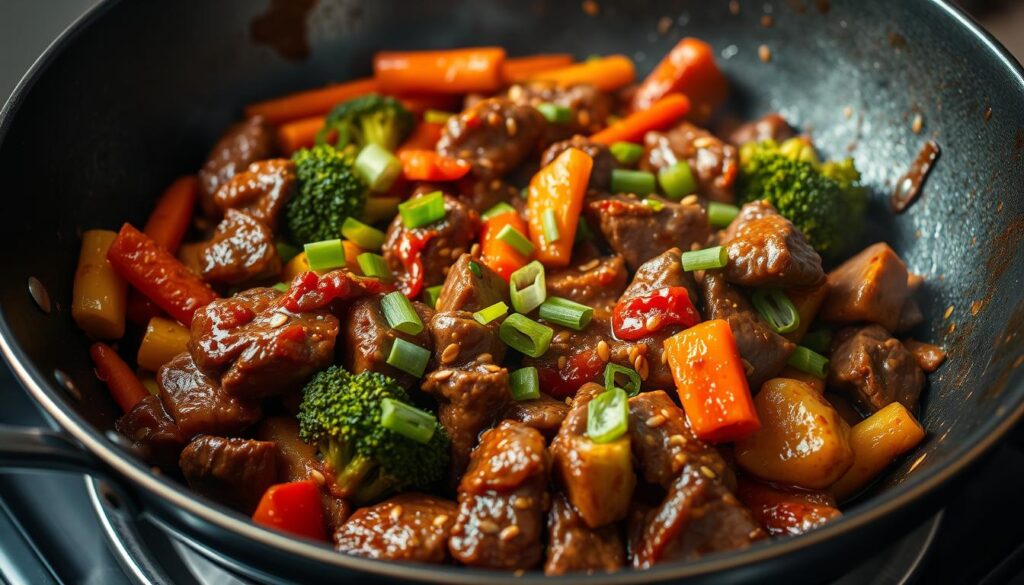
With these changes, you can enjoy your favorite hot and spicy beef dishes healthily. Try different lean cuts, organic options, and healthier swaps. Find the perfect mix of taste and nutrition for your diet.
How to Store Leftover Hot and Spicy Beef
Storing leftover hot and spicy beef right is key to keeping its taste and safety. Whether you’ve made a big batch of spicy beef stir-fry or a pot of hot and spicy beef stew, knowing how to store it is important.
Refrigeration Best Practices
To keep your leftover hot and spicy beef fresh, cool it down fast and store it in an airtight container. This stops bacteria from growing and keeps the flavors good. Use shallow containers to cool the beef quicker, or divide it into smaller parts before refrigerating.
Cooling Methods: Cool the beef quickly with shallow metal pans or ice baths.
Container Selection: Pick airtight containers that fit the dish you’re storing. For example, use containers with tight-fitting lids for saucy dishes like beef Schezwan.
| Dish Type | Container Type | Refrigeration Time |
|---|---|---|
| Saucy Dishes | Airtight Containers | 3-4 Days |
| Drier Preparations | Shallow Containers | 3-4 Days |
Freezing Tips
Freezing is a great way to keep your hot and spicy beef dishes fresh longer. When freezing, use the right packaging to avoid freezer burn and keep flavors good.
Packaging Techniques: Use airtight freezer bags or wrap the beef tightly in plastic wrap or aluminum foil.
Portioning Strategies: Divide the beef into smaller parts before freezing for easier reheating.
Reheating Suggestions
Reheating your leftover hot and spicy beef right is as important as storing it. The goal is to reheat it gently to avoid overcooking or drying out the beef.
Reheating Methods: Use the stovetop, microwave, or oven to reheat your hot and spicy beef. For stovetop reheating, add a little oil or broth to prevent drying out.
Adjusting Seasonings: After reheating, taste and adjust the seasonings as needed. The spice levels and salt perception can change during storage.
The History of Hot and Spicy Beef Dishes
Exploring hot and spicy beef dishes takes you on a journey across continents. These dishes have been shaped by cultures, trade, and cooking traditions.
Cultural Origins
Hot and spicy beef dishes come from various parts of the world. In China’s Sichuan province, Sichuan peppercorns and chili peppers mix to create a unique taste. This mix has inspired dishes globally.
Chili peppers from the Americas changed the game in Asia and beyond. In Goa, India, Portuguese influence led to beef vindaloo. It blends local spices with European cooking.
Evolution of Recipes
Hot and spicy beef recipes have changed over time. They now use new ingredients and cooking methods. Quick spicy beef stir-fry recipes are popular today.
Global migration has led to fusion cuisines. These mix spicy beef traditions from different cultures. This creates new dishes that reflect changing tastes.
Famous Chefs and Their Contributions
Influential chefs have made hot and spicy beef dishes famous. Cecilia Chiang introduced Sichuan cuisine to the US. Rick Bayless explored Mexican cuisine, introducing new flavors.
Today, chefs keep these traditions alive with modern twists. They use new ingredients and techniques. Their work, along with food writers and historians, keeps the cultural value of these dishes alive.
Common Mistakes to Avoid in Hot and Spicy Beef
Making hot and spicy beef is more than just following a recipe. It’s about avoiding common mistakes that can spoil the dish. Whether you’re making a spicy beef stir-fry or a Sichuan beef recipe, knowing these pitfalls can improve your cooking.
Overcooking Proteins
Overcooking is a common problem when making hot and spicy beef. It makes the meat tough and dry, losing its flavor. Understanding protein denaturation and moisture loss is key.
When beef is overcooked, its proteins contract, making it tough. Heat also causes moisture loss, leading to dryness. To avoid this, manage heat and cooking times well.
Tips for Preventing Overcooking:
- Use a thermometer to check internal temperatures.
- Don’t overcrowd the pan, as this lowers the temperature.
- Let the meat rest after cooking to allow juices to redistribute.
Carryover cooking is another important factor. Meat continues to cook after being removed from heat. It’s best to remove it when it’s slightly underdone. This ensures perfect doneness, perfect for dishes like hot & spicy beef.
Underestimating Spice
Misjudging the heat of chili peppers and other spicy ingredients can ruin a dish. It can be too mild or too hot. Knowing how to adjust spice levels is essential.
The Scoville scale helps measure chili heat. But, seed inclusion, membrane removal, and cooking time also affect the heat level.
| Spice Level | Description | Examples |
|---|---|---|
| Mild | Minimal heat, focus on flavor | Beef Schezwan with mild chilies |
| Medium | Balanced heat and flavor | Sichuan beef recipe with balanced spices |
| Hot | Significant heat, bold flavor | Spicy beef stir-fry with hot peppers |
To get the right spiciness, taste as you go and adjust little by little. This way, you can make the dish as spicy as you like. It’s perfect for any occasion.
“The key to great cooking is not just following a recipe, but understanding the nuances of flavor and heat.”
Ignoring Ingredient Quality
The quality of your ingredients greatly affects the taste and texture of hot and spicy beef dishes. Choosing high-quality ingredients is key to the best flavor and texture.
When picking beef, consider the grade and cut. Better beef needs different cooking methods and times. Also, fresh spices and aromatics like garlic and ginger greatly enhance the flavor.
Guidelines for Choosing Quality Ingredients:
- Opt for fresh, high-quality beef suitable for your recipe.
- Select fresh spices and store them properly to maintain potency.
- Use authentic ingredients for traditional dishes to ensure authenticity.
By focusing on these aspects, you can make hot and spicy beef dishes that are delicious and well-balanced. Whether you’re experienced or new to cooking, avoiding these mistakes will improve your dishes.
Final Thoughts on Hot and Spicy Beef
You’ve now explored the vibrant world of hot and spicy beef. From Sichuan beef recipes to simple stir-fries, you’ve seen it all. As you keep trying new dishes, your taste buds will grow to love the bold flavors.
Exploring hot and spicy beef cookery lets you dive into global cuisines. You can make your own spicy stir-fries or beef Schezwan dishes. It’s all about mastering the basics and then getting creative.
Sharing hot and spicy beef with others makes it even more fun. You can host meals that everyone will enjoy, no matter their taste. By sharing your cooking, you’ll make lasting memories and connections.
FAQ
What is hot and spicy beef?
What are the health benefits of hot and spicy beef?
How do I adjust the spice level in hot and spicy beef?
What are some common mistakes to avoid when making hot and spicy beef?
How should I store leftover hot and spicy beef?
Can I make hot and spicy beef healthier?
What are some popular hot and spicy beef brands?
How can I make hot and spicy beef more creative?
What are some tips for perfecting hot and spicy beef?
How can I share hot and spicy beef with others?
For more cooking tips, stay connected with us. We also recommend the cookbook Skinnytaste Simple: Easy, Healthy Recipes with 7 Ingredients or Fewer
For more Recipes about Beef?
Did You try our recipe ?
There are no reviews yet. Be the first one to write one.
